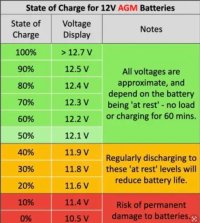for the time being, ignore the overhead display voltage.
I note you say the LB voltage is 12.3v when driving, how were you monitoring this ? Presumably the over head display.
I do not have an SE / Ocean, but the following will give you a starting point to determine if the batteries are receiving a charge from the alternator, having replaced both LBs it is now important to establish if the alternator is working Correctl.
try these rudimentary tests, note the voltage readings & report back:
1) Take a voltage reading directly from the starter battery (SB),
before starting the van,
use a voltmeter to take the reading from the starter battery terminals.
this will give a true indication of the resting voltage of the starter battery. Voltage should be 12.6 V or higher. (If the van has been used recently, refer to WG chart above)
2) Now do the same for the Leisure Batteries (LB) at rest, you can take a voltage reading from one of the rear Cigarette sockets. (Ocean owners may be able to offer better insight into where the sockets are located)
3) Now turn the van ON (all electrics turned OFF, radio, lights, heater etc ) repeat the voltage readings for both SB & LB.
The starter Battery Voltage should now read IRO 13.6 - 14.8v (Whilst the engine is running as the alternator will / should be putting out a charge ?
Which would indicate the Alternator is putting out the correct voltage To the starter battery Initially
3a) The LB voltage may vary depending on the onboard monitoring & prioritisation of the on board monitoring ,
the LB should read a minimum of 12.6 volts, (If it is receiving a charge from the system it should be between 13.6 - 14.8v ? )
3b) now get someone to Rev the engine to approx 2500rpm and note the SB & LB voltages (before & whilst the engine is being held at 2500 Rpm ?
4) now turn on as many electrical systems as possible, lights, radio etc etc, and repeat the voltage readings on SB & LB ? (whilst the engine is running )
& repeat step 3 and note the Voltages
in theory the voltage measured at the starter battery should be circa 13.6 - 14.8v (whilst the engine is running & again whilst there is an electrical draw from lights, radio etc) which indicates the alternator is providing a maximum charge to the SB.
the smart charging system monitors the state and requirement of the SB & compensates to provide the voltage to either the SB or LB depending on the state of charge and the priority programmed by VW.
the LB are charged via the smart monitoring & split charging system which is why the LB voltage may or may not increase when the engine is running (Particularly of the LBs are full)
I.e. the LB side may or may not rise, depending on the state of charge of the SB / LB noted by the monitoring system
a faulty starter battery (bad cell) can cause havoc with the monitoring system,
the monitoring point is on the negative side of the SB battery cable.
if the above tests show a starter battery voltage below 12.6v at rest (at least 30 minutes after being charged for a reasonable time, via the alternator or a 240v smart charger connected directly to the SB for 24hours) it could be the starter battery at fault.
if the SB voltage does not increase to 13.6 - 14.8v with the engine running, it could be an alternator output fault.
6) additionally with the engine off, plug the van in to 240v and take a reading of the LB whilst they are “on charge “ via the 240v socket on the side of the van, what is the reading before and after plugging into 240v ?
LB voltage should show a minimum of 13.6 volts whilst on charge via 240v (actually plugged in to 240v )
Other areas to investigate:
Underneath the SB there are a set of large main vehicle fuses, to access them you need to remove the starter battery and base tray.
if you attempt this, suggest some further reading, The live battery terminals should be placed into an individual plastic bag to prevent it creating a short Circuit which can cause damage.
Disconnecting the SB battery for 30 minutes should reset the monitoring system, so it may benefit to do this and investigate the fuses under the battery
Similarly a bad chassis earth can cause monitoring issues.
isolating the LB circuit by removing the charging relay or fuse can help determine that the SB is working correctly and receiving a charge.
Does your van have start stop ? Is it working correctly ?
I hope that give you some further thing to check and gives you an indication of what the system should be doing, particularly whilst the engine is running

















